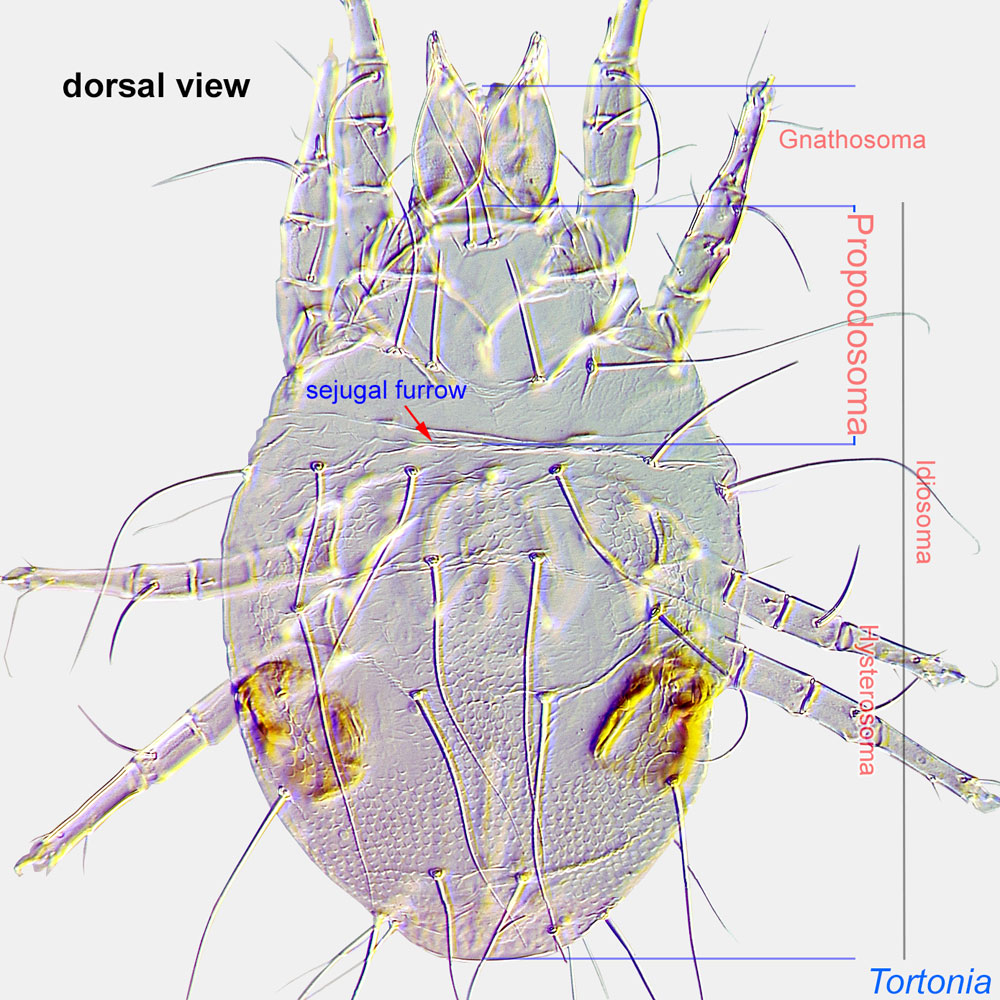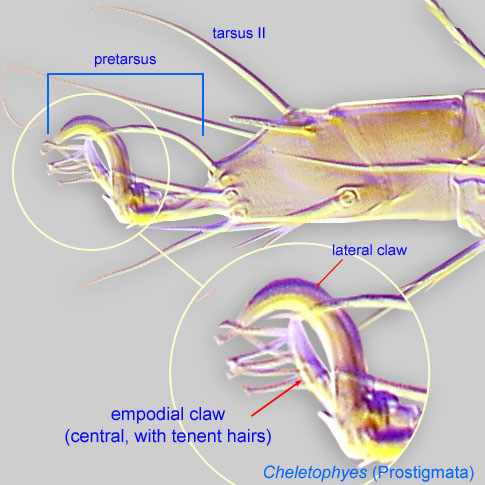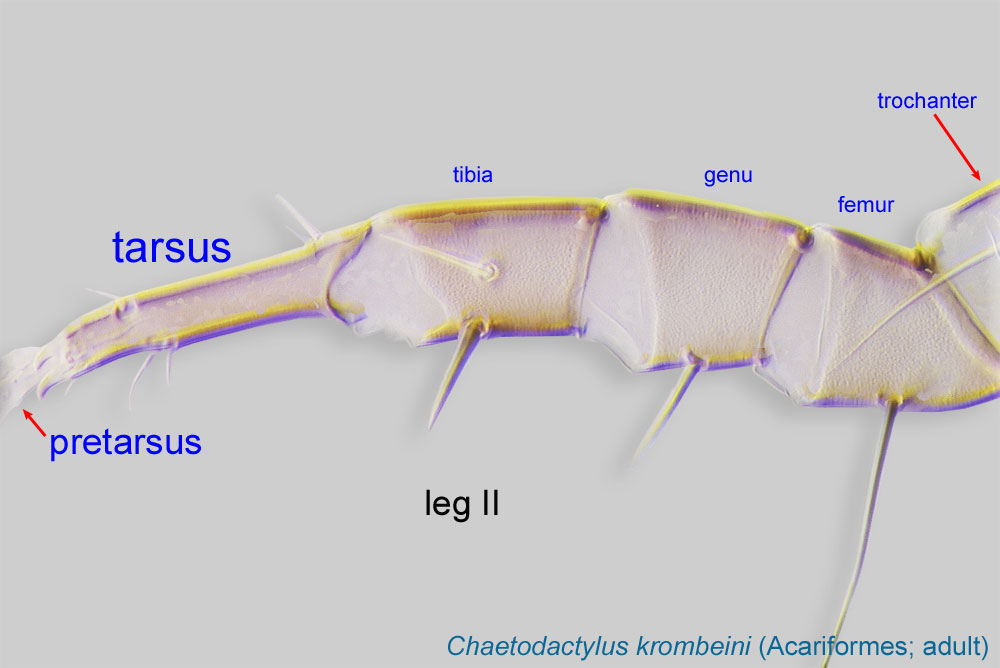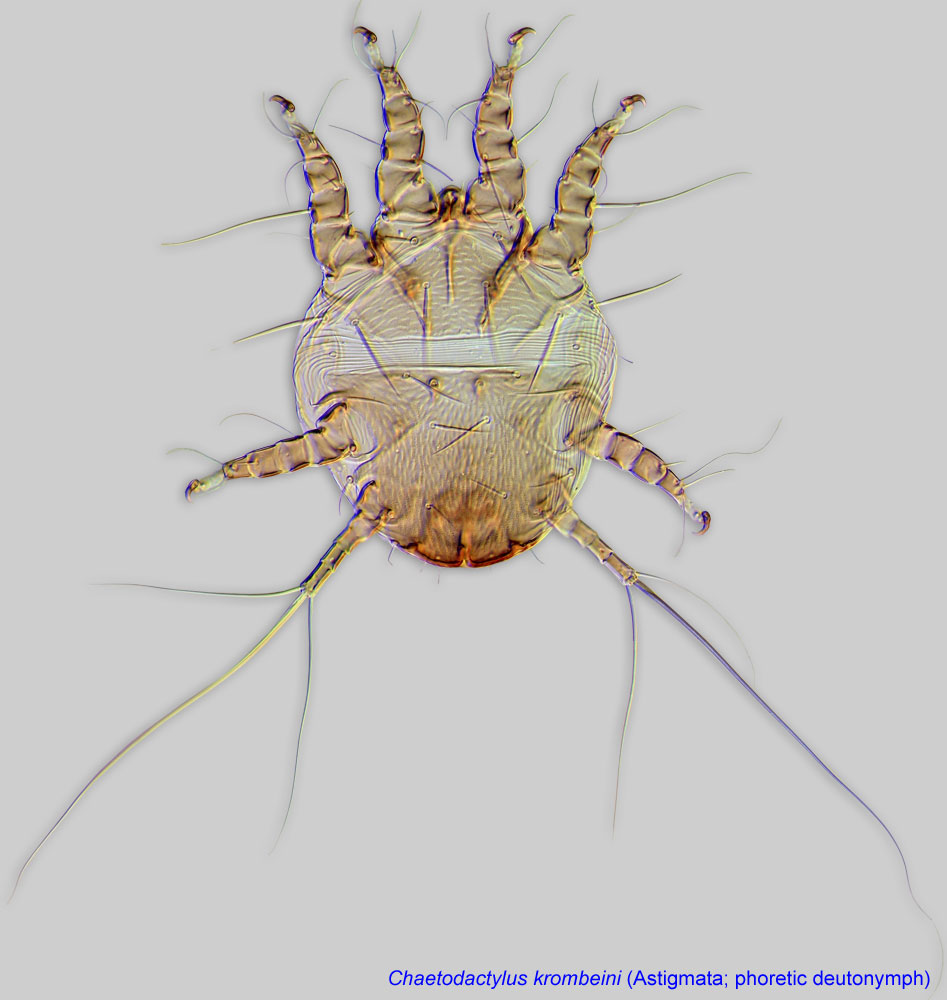neutral to beneficial; feeds on decomposing organic matter in nest cells
Glycycometus Pillai, 1957
Superorder Acariformes » Order Sarcoptiformes » Suborder Oribatida » Infraorder Desmonomata » Hyporder Astigmata » Family Aeroglyphidae » Genus Glycycometus
Austroglycyphagus Fain et Lowry, 1974, Coleochaeta Volgin and Akimov, 1975
Adult: Prodorsumprodorsum:
Dorsal surface of propodosoma.
 with external vertical setae (ve) present, anterior to vi (Fig. 4). Ventral subcapitulumsubcapitulum:
with external vertical setae (ve) present, anterior to vi (Fig. 4). Ventral subcapitulumsubcapitulum:
Ventral faces of the fused palpcoxae.
without external ridges (Fig. 3). Opisthosomaopisthosoma:
Body division posterior to legs IV; usually there is no distinct boundary delimiting this part of idiosoma.
with rows of small, closely spaced microtrichiae (small hair- or tooth-like processes) extending between the bases of most lateral body setae (Figs. 5, 7, 8). Most dorsal setae elongate and heavily barbed, except for c1, which is elongate but smooth (Fig. 5). Pretarsal ambulacraambulacrum:
The claws and empodium of the apotele or pretarsus.
short, relatively simplesimple:
Of claws or setae; not modified or not bi- or trifurcate at tip.
(Figs. 10, 11). Empodial clawsEmpodial claw:
Claw-like, membranous, or pad-like structure of setal origin. Present only on the pretarsus in Acariformes. In Astigmata, it is the only claw on the pretarsus and often referred to simply as the claw. In the remaining Acariformes, may be accomanied by two lateral claws. Also known as empodium, pretarsal empodium, or central claw.
 reduced or absent (Figs. 10, 11). Anus positioned near posterior margin of body (Figs. 2, 6). TarsiTarsus:
reduced or absent (Figs. 10, 11). Anus positioned near posterior margin of body (Figs. 2, 6). TarsiTarsus:
Terminal segment (also known as podomere or palpomere) of legs or palps. In Parasitoformes it can be subdivided into telotarsus and basitarsus.
 I-IV with an elongate scale-like basal seta (Fig. 10, 11). Males with a sclerotized plate posterior to aedeagusaedeagus:
I-IV with an elongate scale-like basal seta (Fig. 10, 11). Males with a sclerotized plate posterior to aedeagusaedeagus:
An external organ of a male arthropod that is specialized to deliver sperm during copulation.
, bearing setae ps3 (Fig. 9).
A dichotomous key is available in Fain and Nadchatram, 1980Fain and Nadchatram, 1980:
Fain, A. amp; M. Nadchatram. 1980. New house-dust mites from Malaysia 1. Two new species of Austroglycyphagus Fain amp; Lowry, 1974 (Astigmata: Glycyphagidae). International Journal of Acarology . 6 : 1-8..
Palaearctic, Afrotropical, Neotropical, Oriental, and Australian regions. This genus is more common in the tropics. Records from bees are from the Afrotropical regions (Tanzania and Rwanda) and Oriental regions (India, Thailand, and The Philippines).
Colonies of these mites have been found in nests of honey bees Apis mellifera, Apis cerana, and Apis florea, and large carpenter bee Xylocopa nigrita. Feeding stages may disperse on mammals and various insects, including bees (Apis mellifera and Apis cerana).
facultativefacultative:
can complete entire life cycle without bees or their close relative, wasps
 .
.Mites of this genus have been found in bird nests, stored food, house dust, bat guano, bracket fungi (Polyporus), and bee nests (Apis spp., and Xylocopa). Dispersing mites have been found on Galagoides demidovii (Prince Demidoff's bushbaby), large flying fox Pteropus vampyrus (a bat), Trirhithrum coffeae (fruit fly of the family Tephritidae), and honey bees (Apis spp.).
Many species found in honey bee nests are generalists also found in other habitats: Glycycometus malaysiensis, Glycycometus molitor, and Glycycometus thailandicus. However, some species have so far been found only in bee nests where they feed on decomposing organic matter in nest cells: Glycycometus geniculatus sensu Vitzthum, Glycycometus rwandae, and Glycycometus combus.
In India, Glycycometus molitor, G. thailandicus, and G. 'orientalis' (nom. nud) have been found in vacated combs, hive debris, brood combs, and dead bees in nests of Apis mellifera and A. cerana. Phoresyphoresy:
Attaching to or boarding another organism (i.e., a host) for dispersal to new habitats. Can be distinguished from parasitism because feeding typically does not occur.
on worker bees has been detected in all three species (Sumangala and Haq, 2001Sumangala and Haq, 2001:
Sumangala, K. amp; M. A. Haq. 2001. Survey of the mite fauna associated with Apis spp. in Kerala, southern India. In Acarology: Proceedings of the 10th International Congress., eds. R. B. Halliday, D. E. Walter, H. C. Proctor, R. A. Norton amp; M. J. Colloff, 565-568. Melbourne: CSIRO Publishing.). Glycycometus malaysiensis and G. thailandicus have been classified as saprophagoussaprophagous:
Feeding on dead or decaying organic matter.
in beehives (Malabanan and Corpuz-Raros, 1998Malabanan and Corpuz-Raros, 1998:
Malabanan, J. M. amp; L. A. Corpuz-Raros. 1998. Mites associated with Apis mellifera Linnaeus and Apis cerana Fabricius in the southern Tagalog region, Philippines. Philippine Entomologist . 12 : 123-135.). Glycycometus combus was isolated from stored, damaged comb of Apis florea; these mites were observed to feed actively and reproduce well on the comb material (Chinniah and Mohanasundaram, 1996Chinniah and Mohanasundaram, 1996:
Chinniah, C. amp; M. Mohanasundaram. 1996. Three new species of mites associated with insects from Tamil Nadu, India. Entomon . 21 : 157-163.).